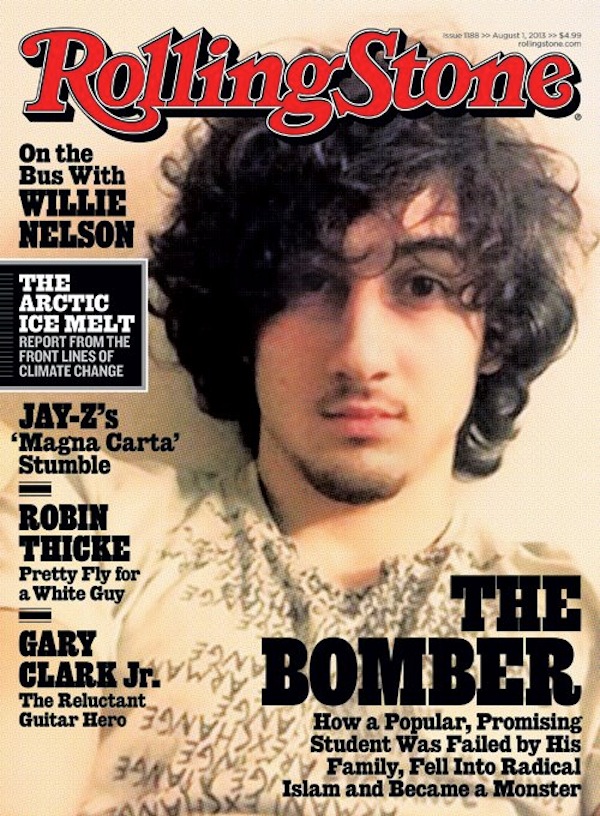Rolling Stone’s Tsarnaev Story Is a Lot Like Their Cover Image
Rolling Stone has posted the article on Dzhokhar Tsarnaev attached to a cover image that has already enraged many corners of the city, along with an editor’s note defending their choices. Whether you think the article’s news value merits giving a bad guy a sought-after cultural space like the cover of Rolling Stone—the alternatives being that they choose a less dreamboat-y photo, as I’ve suggested, or throw some celebrity up on the cover and hope you dig into the issue to find the article anyway—the offending image does come off, in context of the article, as appropriate to the themes explored by the author, Janet Reitman. Just looking at it as a strict question of whether the cover appropriately reflects the story, and not whether the image should have appeared where it did, you’d have to admit that it’s a good fit. That’s because Reitman portrays Tsarnaev as someone with some serious inner turmoil who nonetheless let almost none of it show through. Peter Payack, Tsarnaev’s high school wrestling coach who lost some of his hearing the day of the Marathon while at the finish line, tells Reitman:
“Listen,” says Payack, “there are kids we don’t catch who just fall through the cracks, but this guy was seamless, like a billiard ball. No cracks at all.” And yet a deeply fractured boy lay under that facade; a witness to all of his family’s attempts at a better life as well as to their deep bitterness when those efforts failed and their dreams proved unattainable. As each small disappointment wore on his family, ultimately ripping them apart, it also furthered Jahar’s own disintegration – a series of quiet yet powerful body punches. No one saw a thing. “I knew this kid, and he was a good kid,” Payack says, sadly. “And, apparently, he’s also a monster.”
What better way to reflect this apparent paradox than a photo of a seemingly attractive guy with the word, “monster,” as the cover does? The impression given off after interviews with Tsarnaev’s Cambridge friends, teachers, and coach isn’t an unfamiliar one. From pretty much the first day Tsarnaev’s name came to light, the narrative was that he seemed like a normal, assimilated teenager who had fallen under the influence of his older, more radical brother. Rolling Stone did not invent this angle. They didn’t even invent the idea of pairing this exact photo with stories exploring this angle. They’ve just added more nuance to it, and in the same moment, made a misstep by underestimating the cultural value to which people assign their cover space.
Given the state of indignant rage with which many of us are arriving to the article, there are passages that are sure to irritate. A description of Tsarnaev, as he appeared to friends in Cambridge years before his apparent descent into radicalism, reads:
People in Cambridge thought of 19-year-old Dzhokhar Tsarnaev – “Jahar” to his friends – as a beautiful, tousle-haired boy with a gentle demeanor, soulful brown eyes and the kind of shy, laid-back manner that “made him that dude you could always just vibe with,” one friend says.
He’s described as being sort of a heartthrob in high school. (Although, he was also affectionately nicknamed “Jizz,” so that’s … less flattering.) These are, of course, the “Before” snapshots in a very long story that does not pull its punches when evaluating his acts of evil, but they’re not ones that a lot of people feel comfortable airing out or paying much attention to in light of those evil deeds.
Reading the article today, you get the sense that Tsarnaev’s friends, many of whom are having difficulty reconciling the guy they knew with the perpetrator of the Marathon attack, would be saddened by the reactions to the cover. That is, if this passage is any indication:
That day’s Boston Globe has run a story about the nurses at Beth Israel Deaconess Hospital who took care of Jahar those first few days after his capture. They were ambivalent, to say the least, about spending too much time with him, for fear of, well, liking him. One nurse said she had to stop herself from calling him “hon.” The friends find this story disgusting. “People just have blood in their eyes,” says Jackson.
This article and its accompanying editors note, though not particularly incendiary, probably won’t do much to change that. Such is life when, for whatever complex and opaque reasons, you commit devastating atrocities on innocent people.



